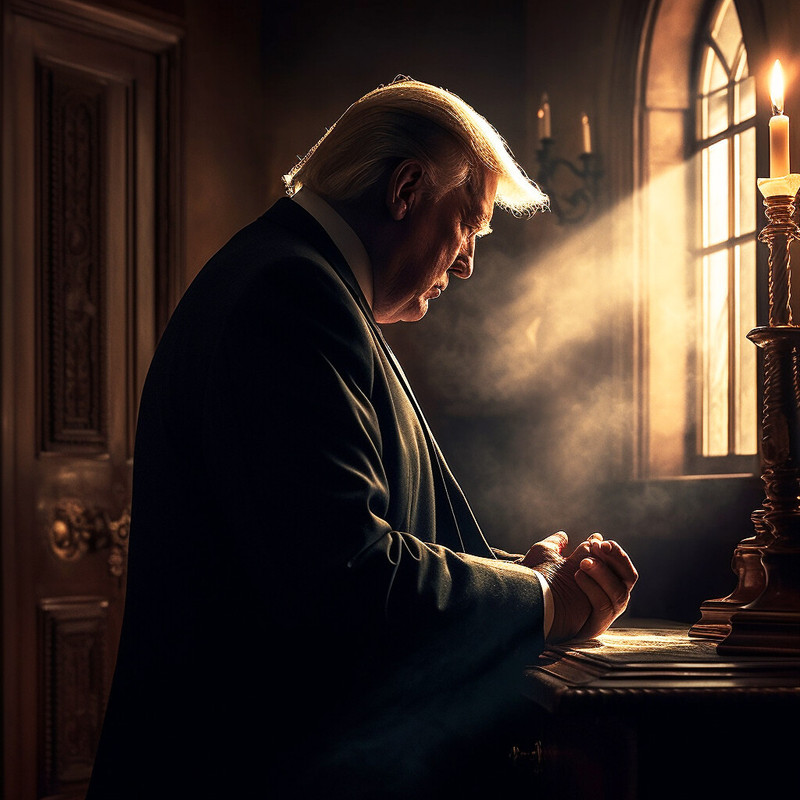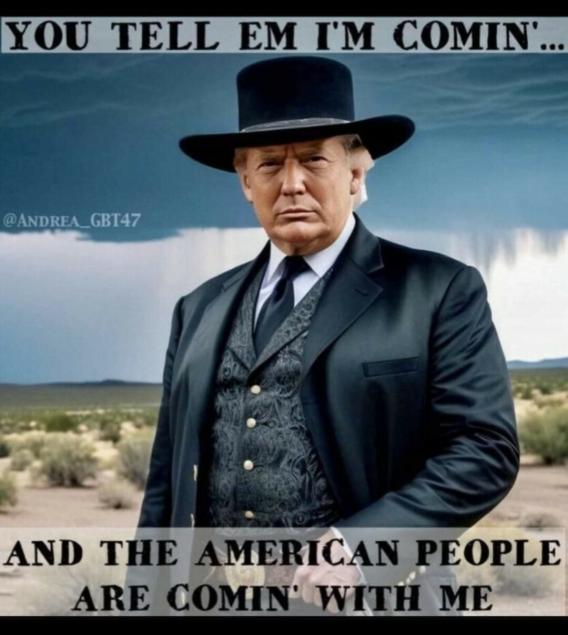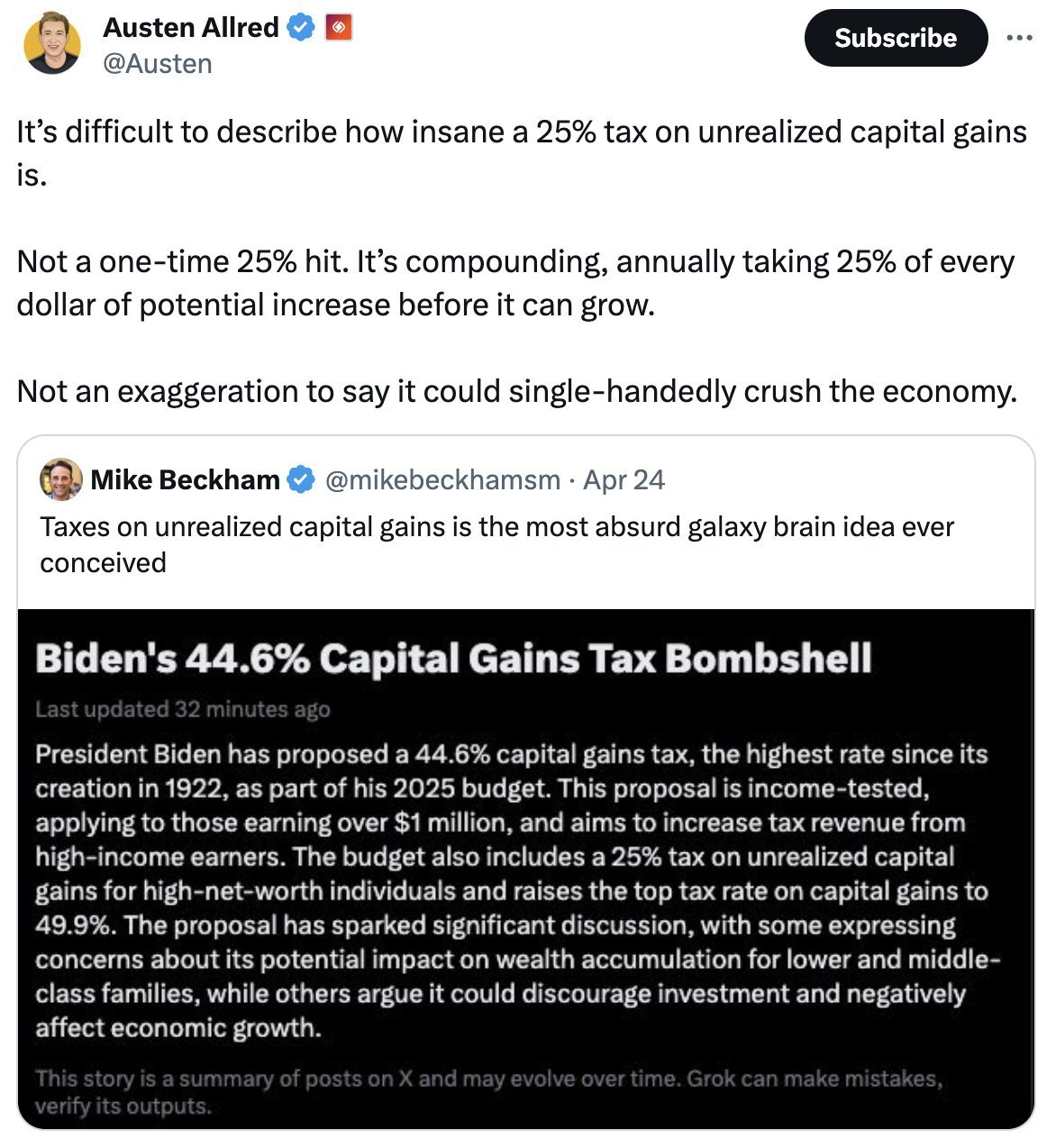Skip to comments.
Honoring President Trump - Trump Family Train: April 1, 2024 – April 30, 2024
4/1/24
| CottonBall
Posted on 03/31/2024 7:43:52 PM PDT by CottonBall
ALL ABOARD THE TRUMP FAMILY TRAIN, EST. 2017 BY DOLLYCALI!
Survived everything thrown at it over the years, just like President Trump....including trolls, moles and saboteurs.

Welcome to the TRUMP FAMILY TRAIN THREAD, where all things Trump are welcome!
Feel free to share news, your comments and opinions, memes, recipes, travel photos... the list is endless.
Posting on behalf of the TFT founder and thread mama, Dolly Cali.

Am I The Only One – Aaron Lewis

TOPICS: Breaking News; Business/Economy; Constitution/Conservatism; Culture/Society; Politics/Elections
KEYWORDS: 45djt47; barron18; breakfastwlysie; cryptobaddddd; flubberjoe; jesusfirst; letsgobrandon; melania; napsrgood; onosnowinmaine; tft; tftbirds; tgkcitalianchick; trumptrain
Navigation: use the links below to view more comments.
first previous 1-20 ... 2,261-2,280, 2,281-2,300, 2,301-2,320 ... 2,461-2,480 next last
To: JudyinCanada
2,281
posted on
04/28/2024 3:25:00 PM PDT
by
norsky
(<P> <a href= > </a> <P><h3> <P><img src=" "width=500"></img>)
To: norsky
Lol the poor kitty looks like it’s going to burst into tears.
2,282
posted on
04/28/2024 3:32:41 PM PDT
by
JudyinCanada
(The left is loathsome, beyond anything I could have believed.)
To: exit82
James Woods
@RealJamesWoods
The American Revolution was first and foremost about an overbearing government, taxing without representation, and suffocating the “common man” with its unbridled power.
____________________________________________________________
The House of Commons passes the Tea Act
On this day in history, April 27, 1773, the House of Commons passes the Tea Act, an act which would lead to the Boston Tea Party and plunge Great Britain and her American colonies into war. The colonists in America had complained about taxes before. They did not mind paying taxes. Rather, their disagreement was with who had the authority to tax them. Since they had no representatives in Parliament, they believed it was unjust for Parliament to tax them. Instead, the proper bodies to tax them should be their own elected assemblies.
When the Stamp Act was passed in 1765, the colonists protested its taxes to the point of violence. When Parliament finally repealed the Act, it passed along with it an act called the Declaratory Act, which reaffirmed Parliament’s right to tax the colonies in whatever way it saw fit. While most celebrated the repeal of the Stamp Act, some saw an ominous sign in the Declaratory Act of more taxes to come.
More taxes did indeed come with the Townshend Acts of 1767, which levied taxes on paper, lead, glass painters’ colors and tea. The colonists responded by protesting and boycotting British goods as usual, forcing Parliament to repeal all of the Townshend Acts’ taxes in 1770, except for the tax on tea, which the colonists continued to boycott. The boycott especially affected the British East India Company, which shipped tea from India to Britain and her colonies.
British policy forced the East India Company to ship tea to England first where it was taxed upon import. Then the tea had to be sold in London markets to merchants who shipped it to America where it was taxed again. The multiple taxes and the middlemen merchants caused the price of tea to be very high by the time it reached consumers in America. This opened up a large market for smuggled Dutch tea, which was much cheaper. By the early 1770s, the East India Company was struggling to survive, with warehouses full of tea it couldn’t sell because its price was undercut in the colonies by Dutch tea.
In order to prevent the East India Company from going bankrupt, Parliament came up with a scheme called the Tea Act, first passed by the House of Commons on April 27, 1773 and passed into law with King George’s signature on May 10. The Tea Act allowed the Company to ship tea directly to the colonies, bypassing the London middlemen and the London duties. The only tax that remained was on the colonies’ end and that tax was quite small. This new scheme greatly reduced the price of British tea. If the colonists bought the lower priced tea, they would also be tacitly agreeing to the notion that Parliament did indeed have the right to tax them.
The colonists, however, no matter how small the tax, had no intention of paying unjust taxes to Britain. They recognized the scheme immediately as an attempt to bribe them into giving Parliament authority to tax them in exchange for cheap goods. The colonists responded by forbidding tea ships from entering their harbors, culminating with the Boston Tea Party, during which 42 tons of tea were dumped into Boston Harbor in protest.
Britain responded in force by passing the Coercive Acts, which closed Boston Harbor and shut down the Massachusetts government, until the tea was paid for. Known as the Intolerable Acts in the colonies, these Acts led directly to the formation of the First Continental Congress to plan a joint colonial response. The American Revolution broke out in full fury shortly afterwards.
Thank you, http://revolutionary-war-and-beyond.com/, for the main body of this essay.
2:06 PM · Apr 27, 2024
2,283
posted on
04/28/2024 4:14:32 PM PDT
by
exit82
(Either the Democrat Party will survive or America will survive. But not both.)
To: exit82
James Woods
@RealJamesWoods
The battles in the southern colonies emerged as the most significant in the end game of the American War of Independence. As General Nathaniel Greene famously declared, “We fight, get beat, rise, and fight again!”
___________________________________________________________
General Greene loses the Battle of Hobkirk’s Hill
On this day in history, April 25, 1781, General Greene loses the Battle of Hobkirk’s Hill near Camden, South Carolina. This was a tactical loss for the Continental Army in the south, but part of an overall strategy that eventually forced the British to abandon the interior of South Carolina and Georgia.
General Nathanael Greene had taken over the decimated American forces in the south in December of 1780. After a string of victories early in 1781, Greene had forced British Lieutenant General Charles Cornwallis to the coast of North Carolina to regroup and resupply. Greene hoped to draw Cornwallis back to the interior to engage him further, but when Cornwallis did not fall for the bait, Greene turned south to reclaim South Carolina.
The British had built a string of forts along the interior of South Carolina and Georgia to hold the back country. Greene broke his forces into several groups that attacked various of these posts in hopes of breaking off their communications and supply lines in order to force them to retreat to the coast.
Greene’s 1,500 men went to the city of Camden, which the British had held for almost a year. Greene knew he did not have the strength to breach the town’s defenses, so he hoped to draw them out of the town and into battle. His men encamped on a ridge known as Hobkirk’s Hill northwest of the town.
On April 25th, British Colonel Francis Rawdon marched out of Camden, just as Greene had hoped and began to march up the ridge. Rawdon’s men marched up the ridge in a narrow formation, allowing Greene to attack from the front and both sides and gain an early advantage that inflicted heavy casualties on the British. Soon after the fight began, however, several of the key American leaders were shot, causing their units to break apart and flee. Rawdon took this advantage and charged up the hill, causing Greene to withdraw in full retreat, even though he had a much larger force. The Americans lost 270 killed, captured, wounded or missing, while the British lost 261.
Rawdon left a small group of dragoons (soldiers on horseback) to hold Hobkirk’s Hill and took the rest of his men back to Camden. After regrouping, however, General Greene brought his men back and they drove the dragoons off and reoccupied the hill.
The Battle of Hobkirk’s Hill was a tactical loss for Greene. Rawdon, however, was virtually trapped in Camden with Greene to the north, General Thomas Sumter to the south, Col. Andrew Pickens to the west and General Francis Marion between Camden and Charleston. The British posts began to fall one by one and Rawdon knew he had to get out of Camden and back to the coast.
On May 9, exactly two weeks after the Battle of Hobkirk’s Hill, Rawdon left Camden, after destroying its public buildings and many private homes, and began the march back to Charleston. Greene’s strategy had worked brilliantly so far by freeing northeastern South Carolina from British rule. By the end of June, all of the interior of Georgia and the Carolinas would be back in American hands and the British would be confined to Charleston and Savannah on the coast.
___________________________________________________________
Thank you, http://revolutionary-war-and-beyond.com/, for the main body of this essay. I suggest you visit this wonderful site for so much insight into the American Revolution. It is obviously my favorite resource.
10:22 AM · Apr 25, 2024
2,284
posted on
04/28/2024 4:21:43 PM PDT
by
exit82
(Either the Democrat Party will survive or America will survive. But not both.)
To: CottonBall
2,285
posted on
04/28/2024 4:24:23 PM PDT
by
DollyCali
(Don't tell God how big your storm is ~~. tell the storm how BIG your GOD is! )
To: exit82
James Woods
@RealJamesWoods
Nathan Hale decides to join the American Revolution
On this day in history, April 22, 1775, Nathan Hale decides to join the American Revolution. Hale was from a New England family that dated back to the founding of the Massachusetts Bay Colony. He grew up in a large farming household in Coventry, Connecticut.
At the age of 14, he went to Yale College in New Haven, where he studied to be a school teacher. He took his first teaching job upon graduating in 1774 in East Haddam, but the following year took a job in New London at the age of 19. Hale was well-liked and known for his conscientiousness and, being college-educated, was held in high regard by the community. Nathan was the first schoolmaster in Connecticut to make regular classes for female students.
Nathan received word that the Revolution had broken out in Massachusetts at the school on April 22, 1775. That evening, the local townspeople had a meeting where Nathan asked to be let out of his contract because he considered it his duty to fight for his country. Hale received a lieutenant’s commission in Connecticut’s 7th Regiment, which left for Boston in September. There they joined the brigade of General John Sullivan and Hale was soon promoted to Captain of the regiment.
Hale saw no military action in Boston and, when the British abandoned the city, he went with the Continental Army to Long Island to defend New York City. Hale’s regiment did not see action here either when the British attacked and took the island, much to Hale’s disappointment. After George Washington moved his army back to Manhattan, the General devised a plan to place a spy within the British ranks on Long Island to find out when and where they would move against Manhattan.
Nathan Hale volunteered for the mission, apparently because he felt that he hadn’t done anything useful yet in the war. Hale was dropped off at Huntington, Long Island on September 12, 1776. Unbeknownst to him, the British would invade Manhattan and drive Washington out of New York on the 15th, making his mission unnecessary, but since Nathan didn’t know it, he continued with his mission.
Nathan posed as a school teacher looking for work and gathered information on British troop movements and strength and eventually made his way back to Huntington where he was to be picked up. Accounts vary on how exactly Nathan was discovered by the British. Some accounts have a Tory relative, a local who recognized him or a British soldier who recognized him, giving him up. At some point, British Lieutenant Colonel Robert Rogers, knowing Hale was a spy, approached him at a tavern and pretended to be a patriot sympathetic to Hale’s views. Hale told him his mission and Rogers captured him.
Hale was immediately sent to New York City and interrogated by General William Howe who, without trial or jury, sentenced him to death. On September 22nd, Hale was marched to a tree in an apple orchard in New York and given the opportunity to say some last words. History tells us Nathan’s last words were, “I only regret that I have but one life to give for my country.” For his bravery and love for his country, he earned a well-deserved spot in America’s pantheon of heroes from the Revolutionary War.
__________________________________________________________
Thank you, http://revolutionary-war-and-beyond.com/, for this essay
10:18 AM · Apr 22, 2024
2,286
posted on
04/28/2024 4:27:36 PM PDT
by
exit82
(Either the Democrat Party will survive or America will survive. But not both.)
To: exit82
James Woods
@RealJamesWoods
President James Monroe is born
On this day in history, April 28, 1758, President James Monroe is born into a Westmoreland County, Virginia plantation owning family. He would fight in the American Revolution, be an Ambassador to France, Secretary of State, Secretary of War and the 5th President of the United States.
James’ father died when he was only 16 years old in 1774, causing him to inherit his father’s plantation and slaves. In the same year, he entered the College of William and Mary to study law. When the American Revolution broke out, James joined the 3rd Virginia Regiment of the Continental Army. He became an officer and participated in a June, 1775 raid on the Governor’s Palace that captured hundreds of weapons for the patriot side.
Monroe fought in Washington’s New York and New Jersey campaigns, where he was wounded in the shoulder at the Battle of Trenton. Monroe is among the people featured in two of the Revolution’s most famous paintings, including Capture of the Hessians at the Battle of Trenton and Washington Crossing the Delaware.
When Monroe’s enlistment expired, he returned to Virginia and studied law with Thomas Jefferson from 1780-1783. He began a practice in Fredericksburg and was first elected to the Virginia House of Delegates in 1782. From 1783-1786, Monroe served in the Continental Congress meeting in New York City.
When the new Constitution was being debated, Monroe opposed it for giving too much power to the federal government, but eventually changed his mind on the condition that a bill of rights be added. Monroe was appointed one of Virginia’s senators to the First Congress where he soon became the Senate’s leader of the Democrat-Republican Party, Jefferson’s and Madison’s party that opposed Washington and the Federalists.
In 1794, Monroe was appointed Minister to France where he was a strong supporter of the French Revolution and opponent of the Jay Treaty with Great Britain, angering George Washington to the point of recalling him. Back in Virginia, Monroe served several terms as Governor and put down a slave revolt. He helped negotiate the Louisiana Purchase in 1803 and became Madison’s Secretary of State and Secretary of War for a period.
Monroe was elected the 5th President of the United States in 1816 and again in 1820. During his administration a harsh economic recession hit America and one of the main public debates revolved around whether or not new states would permit slavery. The Missouri Compromise was adopted during his time in office, which made an equal number of slave and no-slave states. Monroe got into trouble when General Andrew Jackson chased Seminole Indians into Spanish-owned Florida, but he later purchased Florida from the Spaniards for America. Monroe’s most important foreign policy development was the Monroe Doctrine, which demanded that no European powers intervene any longer in the countries of the Western Hemisphere.
Monroe spent his years after the presidency in financial troubles, never gaining financial stability due to poor management and long terms in office. He passed away in New York City on July 4, 1831, 55 years to the day after the Declaration of Independence was adopted. He was the third president to die on July 4th, after Thomas Jefferson and John Adams both died on July 4, 1826.
http://revolutionary-war-and-beyond.com/
5:58 PM · Apr 28, 2024
2,287
posted on
04/28/2024 4:31:51 PM PDT
by
exit82
(Either the Democrat Party will survive or America will survive. But not both.)
To: DollyCali
Just started watching.....wow. President Trump sure knows how to live.
2,288
posted on
04/28/2024 4:34:25 PM PDT
by
JudyinCanada
(The left is loathsome, beyond anything I could have believed.)
To: norsky
2,289
posted on
04/28/2024 4:39:10 PM PDT
by
sweetiepiezer
(WINNING is not getting old!!! ❤️USA❤️)
To: sweetiepiezer
good entertaining cooking tip, PBS Crate TVvneeds to get more like him
2,290
posted on
04/28/2024 4:54:47 PM PDT
by
norsky
(<P> <a href= > </a> <P><h3> <P><img src=" "width=500"></img>)
To: exit82
Both men I’ve heard of — of course, but fine details in their stories were fascinating. Poor Nathan Hale. Wanted to serve and be significant. And did do in his death
3rd President to die july 4th! Interesting tidbit
Thanks for sharing these
2,291
posted on
04/28/2024 5:16:47 PM PDT
by
DollyCali
(Don't tell God how big your storm is ~~. tell the storm how BIG your GOD is! )
To: DollyCali
2,292
posted on
04/28/2024 5:34:29 PM PDT
by
norsky
(<P> <a href= > </a> <P><h3> <P><img src=" "width=500"></img>)
To: exit82
Marisa Numan 🇺🇲
@MarisaNuman
My father, a 40year Army vet died 3/14.At his funeral at Quantico was handed a certificate of service signed by Biden. My parents love Trump. I couldn't bare to hand my mom this certificate. I emailed Melania and asked if she could have her husband write something to her. Look!
7:01 PM · Apr 28, 2024

2,293
posted on
04/28/2024 5:59:51 PM PDT
by
exit82
(Either the Democrat Party will survive or America will survive. But not both.)
To: exit82
2,294
posted on
04/28/2024 6:16:14 PM PDT
by
exit82
(Either the Democrat Party will survive or America will survive. But not both.)
To: exit82
What a beautiful letter from President Trump. Thanks for posting, exit!
2,295
posted on
04/28/2024 6:26:24 PM PDT
by
JudyinCanada
(The left is loathsome, beyond anything I could have believed.)
To: exit82
2,296
posted on
04/28/2024 6:33:39 PM PDT
by
JudyinCanada
(The left is loathsome, beyond anything I could have believed.)
To: exit82; DollyCali; CottonBall; All
2,297
posted on
04/28/2024 6:41:20 PM PDT
by
MS.BEHAVIN
(Women who behave rarely make history.)
To: MS.BEHAVIN
2,298
posted on
04/28/2024 6:44:04 PM PDT
by
JudyinCanada
(The left is loathsome, beyond anything I could have believed.)
To: JudyinCanada
those eyes, he looks so betrayed
2,299
posted on
04/28/2024 6:45:19 PM PDT
by
CottonBall
("We need Trump before any other Americans are killed.")
To: MS.BEHAVIN
Love the moat - it’ll keep the Liberals out!
I don’t think I saw any copper. Unless it’s that green stuff? I have never understood people liking tarnished copper. It’s kind of like liking rust.
2,300
posted on
04/28/2024 6:46:49 PM PDT
by
CottonBall
("We need Trump before any other Americans are killed.")
Navigation: use the links below to view more comments.
first previous 1-20 ... 2,261-2,280, 2,281-2,300, 2,301-2,320 ... 2,461-2,480 next last
Disclaimer:
Opinions posted on Free Republic are those of the individual
posters and do not necessarily represent the opinion of Free Republic or its
management. All materials posted herein are protected by copyright law and the
exemption for fair use of copyrighted works.
FreeRepublic.com is powered by software copyright 2000-2008 John Robinson








